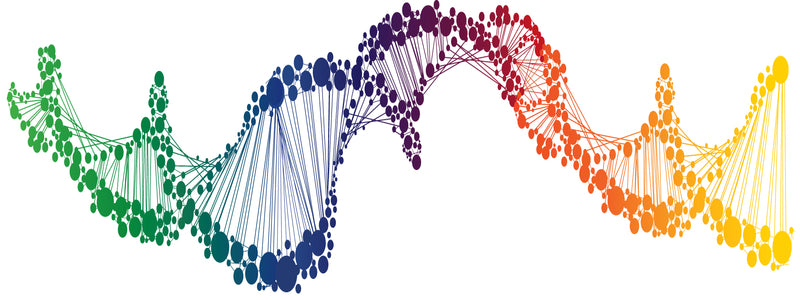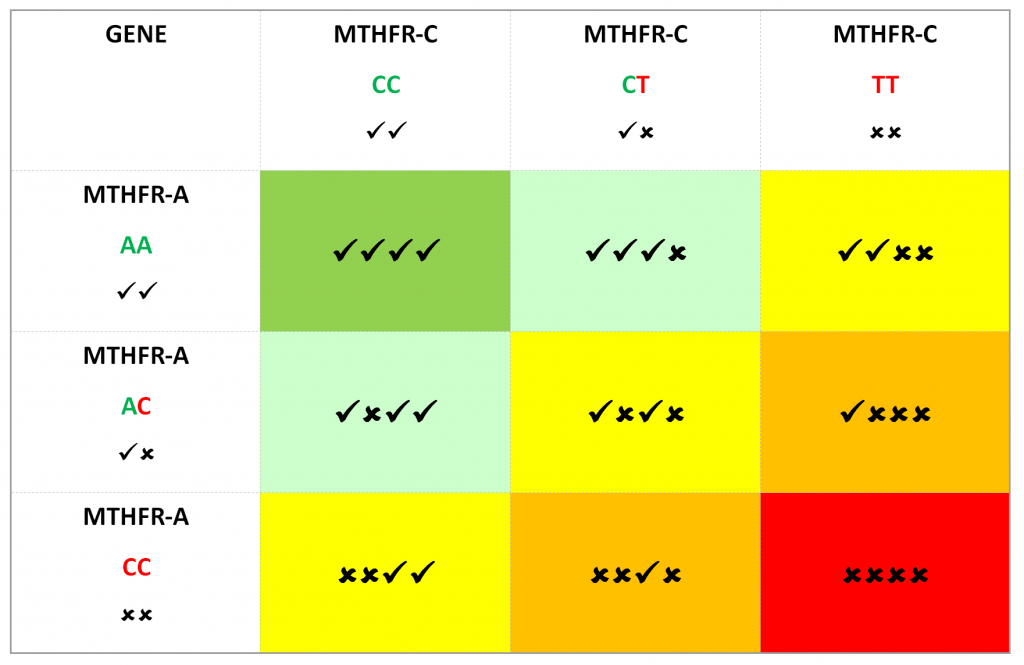
MTHFR C677T Mutation
What Does That Actually Mean?
- C677T or rs1801133 is a genetic variation—a single nucleotide polymorphism (SNP)—in the MTHFR gene.
- You get one copy of this gene from your mother and one from your father, so there are two possible copies that can be either “normal” or “mutant”
- If you inherited one good copy and one bad copy that’s called “heterozygous C677T”
- If you inherited two bad copies (one from each parent) that’s called “homozygous C677T”
- C…T stand for the bases that you actually have. C = cytosine, T = thymine. Bases are essentially the letters that spell out your genetic code. There are four of them commonly (C, T, A and G).
- When this gene is “normal” it looks like MTHFR C677C.
- Heterozygous mutations are MTHFR C677T because there is one normal C and one abnormal T. Also occasionally written 677CT.
- Homozygous C677T can also be written as T677T (because there are two abnormal copies with T instead of C). Occasionally you’ll also see it written 677TT

Individuals with two copies of 677C (677CC) have the most common genotype. 677TT individuals (homozygous) have lower MTHFR activity than CC or CT (heterozygous) individuals
How Much of a Problem Is This?
This can be a significant problem If you don’t have a good diet or you don’t take supplements. If you get lots of dark green leafy veggies, legumes and other food sources of natural folate then you’re probably already getting good methylfolate. If your diet isn’t up to scratch, then supplementation can be useful, See the BIOMEIQ line of MTHFR Certified supplements here
Heterozygous MTHFR C677T have about 65% normal MTHFR activity (so 35% compromise) and homozygous MTHFR C677T (T677T) have about 30% normal activity (so 70% compromise). Normal activity refers to the way your body activates your folic acid so that it can be used, so compromise usually looks like a functional folate deficiency.
We want to make it absolutely clear that while the MTHFR C677T mutation may be common across a number of individuals, the outcome of supplementing with various nutrients can vary tremendously due to other genetic defects, dietary and lifestyle choices and environmental exposures.
What Are The Health Risks of C677T Mutation?
According to SNPedia, which compiles research on genetics, C677T mutants have been shown in at least one research study to have an increased risk for:
-
Cardiac-related issues including:
- Thrombosis (increased tendency to clot inappropriately)
- High homocysteine levels (a heart risk)
- Pre-eclampsia (dangerous high blood pressure in pregnancy)
- Vascular dementia
-
Fertility issues including:
- Multiple pregnancy loss
- Low sperm count
- Birth defects such as down syndrome
-
Neurological issues including:
- Migraines
- Autism
- Alzheimer’s dementia
-
Mood and psychological issues including:
- Depression
- Anxiety
- Schizophrenia
These are some recommendations for the two types of mutations heterozygous (1 copy of C677T) and homozygous (2 copies of C677T) MTHFR mutations.
The biggest differences in recommendations between these two types of mutations are:
- folic acid needs to be avoided more seriously by homozygous individuals
- the amount of methylfolate required for homozygous mutations is greater
- the blood thinning requirement is greater for homozygous individuals
Here are the common recommendations for supporting those with C677T MTHFR mutations:
- Limit ingestion of folic acid in fortified foods as you cannot process folic acid well.
- Limit or cease taking supplements or drugs with folic acid in them. Talk with your doctor before stopping.
- Avoid folic acid blocking drugs such as birth control or Methotrexate.
- Avoid drugs which increase homocysteine such as Nitrous Oxide (most used in dentistry)
- Avoid antacids as they block absorption of vitamin B12 and other nutrients
- Begin understanding which of your symptoms may be related to the C677T MTHFR mutation.
- Inform your family members so they can also test for the MTHFR mutation
- If you are pregnant, find an OB/GYN or midwife who is knowledgeable about MTHFR.
- Eliminate Gluten from your diet – especially wheat.
- Eliminate or reduce Dairy from your diet. If you must have dairy, use Goat milk.
- Sauna or sweat somehow (epsom salt baths, sports, yoga..) at least once to three times a week.
- Limit intake of processed food and use a Detoxification and Metabolic Clearing Formula absolutely essential to support the natural detoxification pathway.
- Increase intake of whole foods and home-prepared meals
- Eat the Rainbow of colors from fruits and vegetables – daily
- Castor Oil Packs over your abdomen daily during times of pain, soreness, cramps
- Limit intake of high methionine-containing foods if homocysteine elevated
- Filter chlorine from your drinking water, shower and bath.
- Drink at least two liters of filtered water daily mixed with vitamin C and electrolytes.
- Eat smaller, but more frequent meals, throughout the day with some form of protein.
- Remove mercury amalgams and root canals with a trained biological dentist.
- Avoid cooking, drinking, storing and heating in any type of plastic container.
- Eat grass-fed beef, free range, hormone free and antibiotic meats and eggs
What Do You Do About This?
A great way to start if you’re unsure, is with a folate-rich diet. Compromise with the MTHFR C677T gene can have severe consequences so it’s important to work on getting good sources of natural folate. Other great supplements are found in BIOMEIQ, is the only company with a certified line of medical grade supplements designed for MTHFR mutations.
Top 10 High Folate Foods
Folate is also considered a B-vitamin and is water soluble, but plays a slightly different role from the other B-vitamins in that it doesn’t participate in energy metabolism.
Folate primarily helps the body make new cells, specifically by playing a role in copying and synthesizing DNA.
Top 10 Folate Rich Foods
1) Garbanzo beans (chickpeas)
½ cup: 557 mcg (over 100% DV)
2) Liver
3 oz: 221 mcg (55% DV)
3) Pinto beans
½ cup: 146 mcg (37% DV)
4) Lentils
½ cup: 179 mcg (45% DV)
5) Spinach
1 cup: 56 mcg (14% DV)
6) Asparagus
½ cup: 134 mcg (33% DV)
7) Avocado
½ cup: 61 mcg (15% DV)
8) Beets
½ cup: 68 mcg (17% DV)
9) Black eyed peas
½ cup: 112 mcg (28% DV)
10) Broccoli
1 cup: 57 mcg (14% DV)
Top Health Benefits of Folate
Healthy Pregnancy
Adequate intakes of folate help reduce the risk of neural tube defects such as spina bifida or anencephaly. A folate deficiency can also cause other birth defects such as heart and limb malformations. Folate is needed for DNA replication, therefore without folate the fetus’ cells are unable to grow properly. Folate is known as possibly the most critical vitamin for a healthy pregnancy.
Fortification of foods with folate by the FDA has decreased the risk for neural tube defects by 26%. It is critical to have adequate levels of blood folate before getting pregnant as the fastest cell replication happens in the early stages. Women should also take a prenatal vitamin during pregnancy to ensure they are meeting their folate needs.
Cancer Prevention
Cancer is caused by DNA damage in individual cells. Since folate plays a role in ensuring proper DNA replication, it can also prevent DNA from becoming damaged and for damaged cells to continue to replicate.
Low blood folate levels are associated with an increased risk of cervical, breast, colon, brain, and lung cancer. The best way to get adequate folate is to eat five or more servings of fruits and vegetables, especially of the green-leafy variety.
Heart Disease
In one study, people who consumed adequate folate were found to have a 55% lower risk of cardiovascular disease than those who did not.
Folate, of all the B-vitamins, plays the most critical role to reduce the levels of homocysteine in the blood, a compound that has been linked with an increased risk of heart attacks and strokes. Blood homocysteine levels have declined since the FDA started requiring folate fortification in many foods.